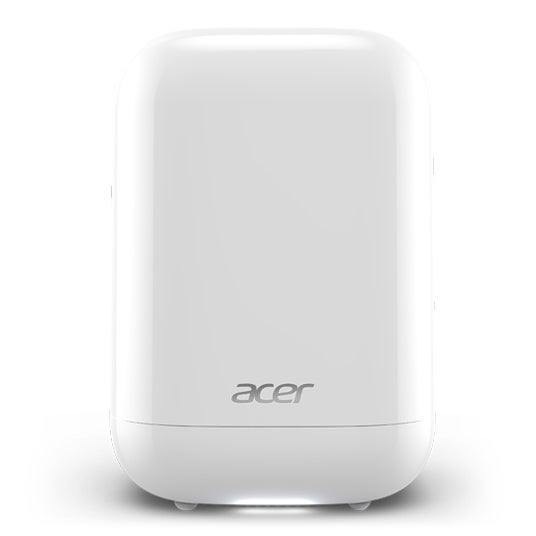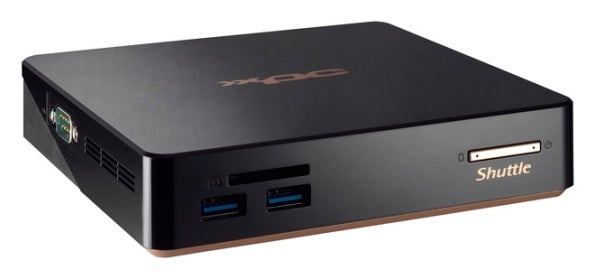Small form-factor PCs have been around for decades and, for the most part, people use them as home media centers to stream audio and video. Over the past several years, however, a new size of PC has emerged—ultra-small form-factor PCs that measure 5- x 5- x 1-inches or even smaller.
While affordable mini PCs can handle home theater and media center tasks, we decided to evaluate five of them from a different point of view. In this article we look at five of the best mini PCs and ways that you can use them in your business. Read and compare all of the mini PC reviews, or go right to a specific mini PC by clicking on one of the links below.
- Acer Revo One
- Shuttle XPC Nano NC01UWIN10HE
- Gigabyte Brix (GB-BXBT-1900)
- Intel NUC5CPYH
- Lenovo IdeaCentre Stick 300
[See also: A Small Business Guide to Document Scanners]
How Mini is a Mini PC?
We looked at five mini PCs that sport an ultra-small form factor. How small are they, exactly? Devices from both Gigabyte and Intel have a 4-inch square case that’s a mere one or two inches thick. Slightly larger, the Shuttle mini PC measures 5-inches square and 1-inch tall. The largest mini PC we tested is the Acer Revo One—it’s about the size of a small bookshelf speaker. Rounding out the group, the seriously small Lenovo IdeaCentre Stick 300 is about the size of a pack of gum.
Acer Revo One, the tallest mini PC in this roundup, stands a mere 6-inches high.
A Business Take on the Best Mini PCs
Mini PCs are not suitable for heavy computer lifting like video editing, CAD, and other processor-intensive tasks. However, they can certainly handle many other business-related chores. For example, each mini PC in our roundup proved capable of web browsing and running LibreOffice Free Office Suite and QuickBooks in-house bookkeeping software. They can all handle cloud-based applications such as Google Office Apps, QuickBooks Online, Xero, and FreshBooks; and they can also act as the anchor for digital signage.
All of the tiny PCs we tested include USB and HDMI ports, so they would also work well as a Skype machine for video conferencing and calling.
These mini PCs have several other things in common. First, they aren’t all that expensive when compared to an equivalent standard desktop. Depending on how you configure them, they can be substantially less expensive than the average desktop.
More importantly, they don’t take up much, if any desk space. Except for the Acer Revo One, you can mount the mini PCs in this roundup on the rear of a monitor using an included VESA mounting plate (the same mount used to attach a monitor or flat-panel TV to the wall). The Revo One stands just about six inches tall, but it takes up only a bit more than 4 square inches on the desktop, so you can easily tuck it behind most displays.
Two Flavors of Mini PC: Ready-to-go or DIY
Here’s an important question to answer when choosing a mini PC: do you want a ready-to-run PC or are you willing to do a little bit of work?
The two mini PCs from Gigabyte and Intel are bare-bones computers. They come in the box with a power supply and a VESA mounting plate, but you don’t get RAM, a hard drive, an or operating system. Adding a stick or two of RAM and a laptop-sized hard drive takes about five minutes; It’s not hard; just about anyone can do it.
You can buy the Windows 7 Home Edition operating system from numerous vendors on-line for less than $100 (though you’ll also need a $20 USB DVD drive to install it), and installing the OS takes about another 20 minutes or so.
The Shuttle XPC Nano, Acer Revo One, and Lenovo IdeaCentre Stick 300 are pretty much ready to run out of the box, though you’ll need a keyboard and mouse for the Shuttle and the Lenovo. The Acer Revo One comes with a wireless keyboard and mouse in the box.
We used a Logitech Bluetooth keyboard and mouse to test the mini PCs that didn’t come with one. And, of course, you’ll also need a monitor, preferably with an HDMI input, which most monitors and even TV sets have these days.
A Guide to the Best Mini PCs
Now that you’re more familiar with the ins and outs of mini PCs, let’s take a look at five of the best mini PCs for business.
1. Acer Revo One
The Acer Revo One, as configured for our roundup, is the most expensive mini PC we tested. It’s also the most highly configured and ready to run out of the box. While Revo One pricing starts at around $280 for a base unit with a Celeron processor, Acer sent us the fully loaded RL85-UR45 model, which carries a $580 price tag.
For that money, the 4.1- x 4.1- x 6-inch Revo comes with an Intel Core i5 Dual-Core processor, 8GB of RAM (the most it supports), and a 1TB hard drive. That’s enough to handle pretty much any common office application you might run on a standard desktop. Acer even includes a wireless keyboard and mouse in the box. The Revo One mini PC we tested came Windows 8.1 installed, and it was ready to use right out of the box.
The shiny white Revo provides two video ports (an HDMI and a DisplayPort output), and you can use both ports at the same time, which means that you can run two monitors. Other ports include a Gigabit Ethernet port, a total of four USB ports (two 2.0 and two 3.0), 7.1 audio, Wi-Fi, and Bluetooth.
Aside from the more powerful CPU and a larger hard disk, what really sets the Revo One apart is that you can stick two additional 2.5 inch hard disk drives (not included) in the compact case. This gives you a huge amount of storage space, or the ability to run the original 1TB drive and an added 1TB in RAID 1 mode, mirroring everything on the original drive to the extra drive for data safety.
2. Shuttle XPC Nano (NC01UWIN10HE)
Shuttle may not be as familiar a brand as the other vendors in this roundup, but it’s been selling mini PCs in the U.S. for more than 25 years. The Nano goes small form-factor one better, measuring a scant 5- x 5- x 1.14-inches. The Shuttle is also ready to run out of the box, though first-time setup takes about 10 minutes for Windows 10 Home to initialize.
Priced at $280, the XPC Nano comes with a VESA mounting plate so you can attach it to the back of a display. As with most of the mini PCs we tested, the Shuttle does not include a keyboard or mouse—we used a set we keep on hand for reviews.
The very lightly configured Nano features a dual-core Intel Celeron 3205U processor, which is fine for basic business tasks you might want to accomplish with this mini PC. You can opt for Core i5 and Core i7 models if your business requires something a bit more high-powered. But as delivered, with 2GB of RAM and a 32GB hard disk, it’s a little underpowered for running something like an office suite directly from the hard drive—although cloud-based applications, including Google Office apps, run just fine in a Chrome browser.
The Nano comes with an M.2 SATA drive, a solid state drive in circuit board form, designed for small form factor PCs. The case has room for an additional 2.5-inch laptop type hard disk, and you can buy a 500GB drive online for about $60, so it’s a good upgrade for this model. The xpc Nano also has two DIMM sockets for RAM, so adding another 4GB or 8GB of RAM won’t cost much. That will bump the price up a bit, but it will really improve performance.
In the port department, the XPC Nano holds its own with the other mini PCs we tested. It has two video outputs, an HDMI and a mini-Displayport, two USB 2.0 ports, two more USB 3.0 ports, Gigabyte Ethernet, Wi-Fi, Bluetooth, and an SD Card reader.



